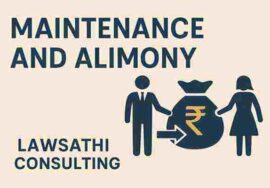Process for Mutual Divorce
Step-by-Step Process for Mutual Divorce
Joint Petition Filing:
Both spouses file a joint petition for divorce in the family court.
The petition should be filed under Section 13B of the Hindu Marriage Act, 1955.
The petition must state that both parties have been living separately for a period of at least one year and have mutually agreed to dissolve the marriage.
First Motion:
The court examines the petition and, if satisfied, records the statements of both parties.
The court then passes an order on the first motion.
A cooling-off period of six months is provided to the couple to reconsider their decision.
Cooling-off Period:
During this six-month period, both parties have the opportunity to resolve their differences and reconsider their decision to divorce.
If they wish to reconcile, they can withdraw the petition.
Second Motion:
After the cooling-off period, if both parties still wish to proceed with the divorce, they file a second motion.
This must be done within 18 months from the date of the first motion.
The court again records the statements of both parties.
Final Hearing:
The court examines the case and verifies that all conditions for mutual consent divorce are met.
Both parties must appear before the court for the final hearing.
Decree of Divorce:
If the court is satisfied with the statements and the evidence, it grants a decree of divorce.
The marriage is legally dissolved from the date of the decree.
Documents Required
Address Proof: Both spouses need to provide their address proof.
Marriage Certificate: A copy of the marriage certificate.
Photographs: Recent passport-sized photographs of both spouses.
Evidence of Separation: Proof that the couple has been living separately for more than one year.
Income Tax Statements: Income tax statements for the last 2-3 years.
Details of Profession and Income: Information about the profession and present income of both spouses.
Family Background Information: Details about the family background of both spouses.
Important Points to Remember
Legal Consultation: It is advisable to consult a lawyer who specializes in family law to guide you through the process.
Mutual Agreement: Ensure that both parties are in full agreement regarding all terms, including alimony, child custody, and property division.
Court Fees: Be prepared to pay the court fees associated with filing the divorce petition.
The process of obtaining a mutual divorce in Delhi involves filing a joint petition, undergoing a cooling-off period, and appearing for hearings. With mutual consent and the right documentation, the procedure can be relatively straightforward and less time-consuming compared to a contested divorce.
What is Mutual Divorce?
Mutual Divorce is a type of divorce where both spouses agree to end their marriage amicably and without any disputes. This form of divorce is based on mutual consent and understanding between the couple.
Mutual Divorce
Mutual Consent: Both spouses agree to the divorce and the terms associated with it, such as child custody, alimony, and division of property.
Amicable Resolution: Since both parties are in agreement, the process avoids lengthy legal battles and reduces emotional stress.
Legal Procedure: The couple jointly files a petition for divorce in the family court, citing that they have been living separately for a specified period (usually one year) and are unable to live together.
Cooling-off Period: After the first motion is filed, the court typically provides a cooling-off period of six months to give the couple time to reconsider their decision.
Final Decree: If the couple still wishes to proceed with the divorce after the cooling-off period, they file a second motion. The court then reviews the case, and if satisfied, grants a decree of divorce.
Advantages of Mutual Divorce
Faster Process: The mutual consent divorce process is generally quicker compared to a contested divorce.
Cost-Effective: Since there are no disputes, legal fees and court costs are lower.
Less Stressful: The amicable nature of the process reduces emotional and psychological stress for both parties.
Privacy: Details of the divorce settlement are less likely to be publicly contested, preserving the privacy of both parties.
Who Can Apply for Mutual Divorce?
Mutual Divorce can be applied for by any married couple who mutually agrees to end their marriage. Here are the specific criteria and conditions under which a couple can apply for mutual divorce:
Mutual Consent:
Both spouses must agree to the divorce without any coercion, force, or undue influence.
The decision to divorce should be a result of mutual understanding and agreement.
Living Separately:
The couple must have been living separately for a period of at least one year before filing the petition.
“Living separately” does not necessarily mean living in different locations; it implies that the couple has not been living as husband and wife.
Irretrievable Breakdown of Marriage:
Both parties must believe that their marriage has broken down irretrievably and that there is no possibility of reconciliation.
Joint Petition:
The couple must file a joint petition for divorce in the family court, indicating their mutual consent for the divorce.
Mutual divorce is accessible to any married couple who agrees to the terms of the divorce and meets the legal requirements. By fulfilling the criteria of mutual consent, living separately, and believing in the irretrievable breakdown of the marriage, couples can apply for mutual divorce.
Disclaimer: This article is for educational and informational purposes only. It provides a general understanding of legal remedies but does not constitute legal advice. For specific legal guidance, you can just consult the legal matter expert.






